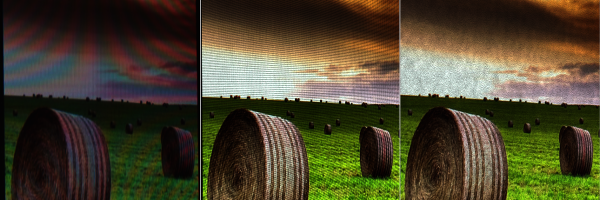
Left to right: Real in-camera Moire, synthetic Moire rendered in Houdini, and a synthetic panel rendered with a scattered pixel distribution to eliminate Moire.
Very happy to announce the completion of a Technical Report based on my LED panel experiments conducted in November 2021.
Title: A comparison of LED panels for use in Virtual Production: Findings and recommendations.
Abstract: We evaluate four LED panels from three vendors for use in Virtual Production using experimental conditions. Tests were designed to assess Moire and scan-line artefacts, light reflectivity and grazing angle. We discuss LED manufacturing processes and the implications of these on visual artefacts, power consumption and colour fidelity, and conclude with results and recommendations for LED vendors, practitioners and procurement teams in Virtual Production.
Paper: Accessible here.
Supporting Videos: Moire and Scanline, Track Test, Light Bounce Test, Grazing Angle Test
- Colour reproduction is very important, and influenced by manufacturing decisions (e.g. binning). It is a well–understood practice to replace panels from a set from the same batch to ensure consistency. It would behoove any procurement team to investigate samples and (ideally) measure the colour reproduction in order to ensure it is appropriate for a particular application.
- Manufacturing decisions greatly influence the brightness and cost of LED panels. Brighter panels need less power to achieve equivalent brightness, so power draw could theoretically be cut significantly by choosing alternative manufacturing approaches or selecting LED’s based on brightness.
- By modifying the layout of pixels on the display, or adjusting the sampling strategy of the camera, Moire artefacts could potentially be eliminated altogether, although the manufacturing and rendering complexity of doing this have not been considered in this paper.
- By publishing both the reflectance distribution function of the back panel and emission patterns of the LED’s, manufacturers would allow studio planners to accurately simulate the panel and lighting design of a virtual production studio, eliminating the need to publish the contrast ratio.
- Deric Zhou and Jason Yang (AOTO)
- Liam Winter and Blaine Johnstone (PSCo Ltd)
- Christian Czimny (Absen), and
- Luc Neyt, Victor Kortekaas and David Morris (ROE Visual).
Recent Comments